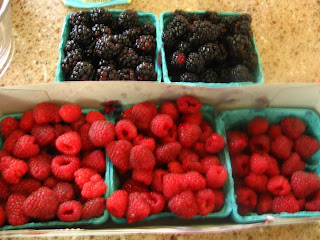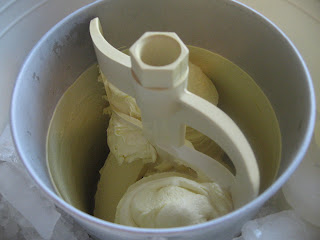
Monday, October 19, 2009
Red, Green and RAW

Tuesday, October 6, 2009
Front Yard Harvest
Sunday, September 20, 2009
Labor Day Eat-In
By giving schools the resources to serve real food, we can grant 30 million children the freedom to be healthy. By teaching children to eat well, we can make a down payment on health care reform. By providing children with locally grown fruits and vegetables, we can support local farmers and create green jobs in our communities. By purchasing local food, we can stop wasting oil on transportation and start curbing global warming. By raising children who enjoy real food, we can start laying the foundation for America's future prosperity.
This fall, the Child Nutrition Act, which is the bill that governs the National School Lunch Program, is up for reauthorization in Congress. By passing a Child Nutrition Act that works for children, our nation can take the first step towards a future where no child is denied his or her right to be healthy and where every child enjoys real food.
That’s why it’s time for Congress and the Obama Administration to:
1. INVEST IN CHILDREN’S HEALTH.
Give schools just one dollar more per day for each child’s lunch.
2. PROTECT AGAINST FOODS THAT PUT CHILDREN AT RISK.
Establish strong standards for all food sold at school, including food from vending machines and
school fast food.
3. TEACH CHILDREN HEALTHY HABITS THAT WILL LAST THROUGH LIFE.
Fund grants for innovative Farm to School programs and school gardens.
4. GIVE SCHOOLS THE INCENTIVE TO BUY LOCAL.
Establish financial incentives that encourage schools to buy food from local farms for all child
nutrition programs.
5. CREATE GREEN JOBS WITH A SCHOOL LUNCH CORPS.
Train underemployed Americans to be the teachers, farmers, cooks, and administrators our
school cafeterias need.
More details can be found here.
Slow Food USA has an online petition that has been signed by 21,868 people so far. It only takes a minute to sign it. If you believe in what is trying to be accomplished by this campaign please go and sign the petition here.

Anna at the Eat-In

Enjoying my delicious plate of food
August Meeting - Fantastic Fruit Crisps and Cobblers



Saturday, August 8, 2009
Julie and Julia
I think the two cookbook authors whom I have truly learned how to cook from, have been Deborah Madison and Alice Waters. Their cookbooks are my bibles.
Michael Pollan wrote a wonderful article talking about the influence Julia Child had and how she was different from the current chefs who are on the Food Network nowadays. I found it rather eye-opening.
Thursday, August 6, 2009
The Summer Garden
 Orange orbs bursting with flavor
Orange orbs bursting with flavor So many deliciously sweet tomatoes!
So many deliciously sweet tomatoes! The Big Ones
The Big Ones Box o' Tomatoes
Box o' Tomatoes The Lonely Zucchini
The Lonely Zucchini Squash Blossoms
Squash Blossoms  Chives
Chives The tomato harvest (with mint and thyme in the background)
The tomato harvest (with mint and thyme in the background)With all these delicious tomatoes, I knew I needed to make something for dinner that really highlighted the fresh picked sweetness of these pizza. What better way than a homemade pizza!
This is one of my favorite pizzas, the recipe is from Deborah Madison's, Vegetarian Cooking For Everyone. It's called "Zucchini Pizza with Cherry Tomatoes and Goat Cheese." It has zucchini and fresh mozzarella, and then you make a mixture of of the sliced cherry tomatoes with a little garlic, basil, olive oil, salt and pepper. This is sprinkled on top and then you sprinkle goat cheese (feta cheese works as well). As soon as it comes out of the oven you sprinkle more fresh basil and brush the crust with garlic olive oil. The crust is simply a home made pizza dough of whole wheat / white flour. It's very thin and crispy. What really makes this pizza special is the freshly picked, homegrown, tomatoes.
Wednesday, August 5, 2009
July Ravioli Making




 One of the coolest tools ever, the ravioli mold. Put one layer of pasta dough, then the filling, then cover with the second layer of dough, go over it with a rolling pin, and voila! One dozen ravioli have been made.
One of the coolest tools ever, the ravioli mold. Put one layer of pasta dough, then the filling, then cover with the second layer of dough, go over it with a rolling pin, and voila! One dozen ravioli have been made. 
 The tomato sauce we made to go on our ravioli. This was some of the most amazing tomato sauce ever. I learned that to make authentic tomato sauce like they make in Italy, you need a food mill, and after the sauce has been cooking for a while, you run it all through the food mill and it ends up having an amazingly smooth texture.
The tomato sauce we made to go on our ravioli. This was some of the most amazing tomato sauce ever. I learned that to make authentic tomato sauce like they make in Italy, you need a food mill, and after the sauce has been cooking for a while, you run it all through the food mill and it ends up having an amazingly smooth texture. Alameda Plum Ice Cream
On a rare Alameda day that actually felt like summer (as in, it was pretty hot out) I happened to have heavy cream in the fridge and I felt like making a dessert. I decided to make some ice cream. Only a few months ago, did I even learn that my mom actually owned an ice cream maker. I followed the recipe in Alice Water's "The Art of Simple Food."
As Alice says, "Ice Cream is universally loved -- and homemade ice cream right off the dasher is the most desirable ice cream of all. There are basically two versions. The first is simply sweetened and flavored cream, frozen. The second is a frozen custard made with sweetened cream and egg yolks, which produces a richer, smoother ice cream."
I followed the recipe for the custard style. I did a variation on the recipe, using plums instead of strawberries. These plums were very small, rather tart plums that weren't that great for eating on their own. They were off of someones plum tree here in Alameda, because my mom picked them up off of Stephanie's porch through the Alameda Fruit Exchange.

I pitted the plums and then heated them over the stove with some sugar. After this, I pureed them in the food processor. I then made the custard/cream mixture and let it cool. Once it was cool, I added in the pureed plums. I put the mixture in the ice cream maker and let it work its magic!
The ice cream turned out just right, sweet, but with some natural tartness from the plums, and very creamy. It was delicious. It was a pale peachy orange color with flecks of red. It was so rich that it took a very small amount to completely satisfy.
Tuesday, July 7, 2009
Pizza and Fro Yo
One of the most important things when making a good homemade pizza is having a pizza stone for the oven. By pre-heating the oven for half an hour at 500 degrees with the pizza stone in it, the pizza will have a crisp crust without overcooking the toppings. A pizza peel is also helpful in getting the pizza into and out of the oven. I use a fine cornmeal to keep the dough from sticking to the peel. There's nothing worse than having a pizza covered in toppings and ready to go into the oven, only to discover that one part of the dough is stuck to the peel.
 Before
Before After
AfterThe article recommended using a very high quality yogurt with no additives, so we used the nonfat Straus European style yogurt. Actually, I think it was the nonfat plain european style yogurt from Trader Joes's. (Interesting little side note: When I went to Slow Food Nation in SF last year, I talked to the guy at the Straus Creamery booth and he said that the plain European style yogurt at Trader Joe's is actually Straus yogurt. But only the plain nonfat and whole fat European style ones.)
A few days before the meeting I had went out to Brentwood with my mom and my friend Ruth to pick cherries. We had two paper grocery bags almost full of cherries. So at cooking club we made a cherry sauce for the frozen yogurt (fro yo). The sauce was simply pitting the cherries and cutting them in half, and then sauteeing them over medium high heat with some sugar until the sugar caramelized a bit and the cherries released some of their juice.



































